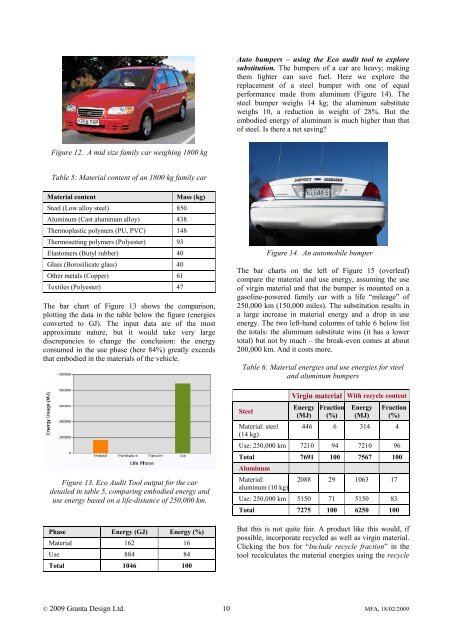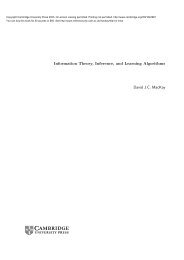The CES EduPack Eco Audit Tool ? A White Paper - MAELabs UCSD
The CES EduPack Eco Audit Tool ? A White Paper - MAELabs UCSD
The CES EduPack Eco Audit Tool ? A White Paper - MAELabs UCSD
You also want an ePaper? Increase the reach of your titles
YUMPU automatically turns print PDFs into web optimized ePapers that Google loves.
Figure 12. A mid size family car weighing 1800 kg<br />
Table 5: Material content of an 1800 kg family car<br />
Material content Mass (kg)<br />
Steel (Low alloy steel) 850<br />
Aluminum (Cast aluminum alloy) 438<br />
<strong>The</strong>rmoplastic polymers (PU, PVC) 148<br />
<strong>The</strong>rmosetting polymers (Polyester) 93<br />
Elastomers (Butyl rubber) 40<br />
Glass (Borosilicate glass) 40<br />
Other metals (Copper) 61<br />
Textiles (Polyester) 47<br />
<strong>The</strong> bar chart of Figure 13 shows the comparison,<br />
plotting the data in the table below the figure (energies<br />
converted to GJ). <strong>The</strong> input data are of the most<br />
approximate nature, but it would take very large<br />
discrepancies to change the conclusion: the energy<br />
consumed in the use phase (here 84%) greatly exceeds<br />
that embodied in the materials of the vehicle.<br />
Figure 13. <strong>Eco</strong> <strong>Audit</strong> <strong>Tool</strong> output for the car<br />
detailed in table 5, comparing embodied energy and<br />
use energy based on a life-distance of 250,000 km.<br />
Phase Energy (GJ) Energy (%)<br />
Material 162 16<br />
Use 884 84<br />
Total 1046 100<br />
Auto bumpers – using the <strong>Eco</strong> audit tool to explore<br />
substitution. <strong>The</strong> bumpers of a car are heavy; making<br />
them lighter can save fuel. Here we explore the<br />
replacement of a steel bumper with one of equal<br />
performance made from aluminum (Figure 14). <strong>The</strong><br />
steel bumper weighs 14 kg; the aluminum substitute<br />
weighs 10, a reduction in weight of 28%. But the<br />
embodied energy of aluminum is much higher than that<br />
of steel. Is there a net saving?<br />
Figure 14. An automobile bumper<br />
<strong>The</strong> bar charts on the left of Figure 15 (overleaf)<br />
compare the material and use energy, assuming the use<br />
of virgin material and that the bumper is mounted on a<br />
gasoline-powered family car with a life “mileage” of<br />
250,000 km (150,000 miles). <strong>The</strong> substitution results in<br />
a large increase in material energy and a drop in use<br />
energy. <strong>The</strong> two left-hand columns of table 6 below list<br />
the totals: the aluminum substitute wins (it has a lower<br />
total) but not by much – the break-even comes at about<br />
200,000 km. And it costs more.<br />
Table 6: Material energies and use energies for steel<br />
and aluminum bumpers<br />
Virgin material With recycle content<br />
© 2009 Granta Design Ltd. 10 MFA, 18/02/2009<br />
Steel<br />
Material: steel<br />
(14 kg)<br />
Energy<br />
(MJ)<br />
Fraction<br />
(%)<br />
Energy<br />
(MJ)<br />
Fraction<br />
(%)<br />
446 6 314 4<br />
Use: 250,000 km 7210 94 7210 96<br />
Total 7691 100 7567 100<br />
Aluminum<br />
Material:<br />
aluminum (10 kg)<br />
2088 29 1063 17<br />
Use: 250,000 km 5150 71 5150 83<br />
Total 7275 100 6250 100<br />
But this is not quite fair. A product like this would, if<br />
possible, incorporate recycled as well as virgin material.<br />
Clicking the box for “Include recycle fraction” in the<br />
tool recalculates the material energies using the recycle
















